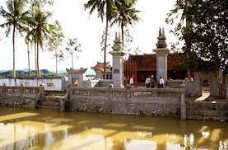
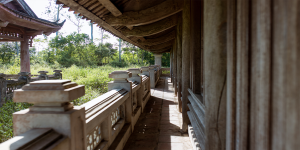
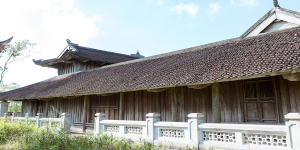
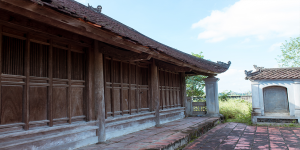
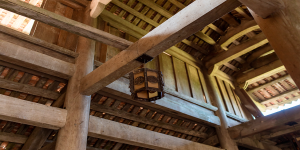
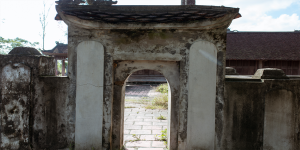
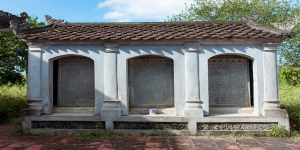
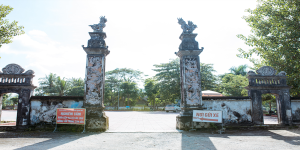
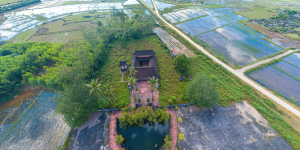
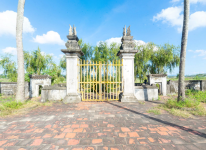
Camera tour
Price: Free
Time to visit a place: 120 phút
Open Time: 7:00 AM - Close Time: 6:00 PM
Address: Vo Liet Village, Thanh Chuong District, Nghe An Province
VO LIET COMMUNAL HOUSE - SOVIET'S HEADQUARTERS IN THE NGHE-TINH SOVIET MOVEMENT IN 1930 - 1931
Go to Thanh Chuong along Highway 46 connecting Ho Chi Minh road, cross Ro bridge, turn right 500m, you will see Vo Liet communal house prominent on the high mound in the Re field.
Vo Liet Communal House is also known as Quan Hang Tong, founded by Vo Liet commune's Literature Association. The communal house was built in 1859 and completed in 1860, the design leader was Mr. Hoang Chinh Truc. Vo Liet is a studious locality with many passers-by, so before building, Mr. Hoang Chinh Truc studied, visited and toured to learn about architecture in Thang Long, Thanh Hoa and made a model of a bamboo communal house placed in Ro market to consult the people's opinion. The construction of Vo Liet communal house was elaborately prepared, the materials were made of ironwood, jackfruit wood.
Vo Liet Communal House is a unique architectural relic in the system of Vietnamese communal houses. There is a semicircular lake, gate, garden and main hall. From the outside, the communal house gate has a "four-pillar" structure with 4 solid gate pillars forming 1 main gate and 2 auxiliary gates. In front of two sides of the communal house yard, two rows of stele houses were built, each house had 3 monolithic green stone steles with full names and addresses of 445 people who passed the exam of Vo Liet commune from the Le dynasty to the Nguyen dynasty, including 377 Baccalaureate, 63 Bachelors, 2 Doctorates and 3 Associate Doctorates. The communal house has a square architecture, also known as the structure of the word "Khẩu", which is a closed, interconnected house, there is a courtyard in the middle with 54 columns connected horizontally, vertically and closed by iron boards. The row of houses in front of 5 main compartments 2 auxiliary compartments is 5.35m high, 16.8m long, linked together by 6 sets of trusses. Next, there are two rows of left and right houses built opposite to form a covered path with 3 compartments for each, 4 columns 4.3m high. Continuity of the eight-roofed house, including 5 main compartments, 2 auxiliary compartments, 7m high. On the top of the roof of the communal house, there is a shape of patterned wine bottle, knife-heads in the communal house bend softly, on the residual ends are stylized dragons, the dragons are quite ingenious, both carrying a decorative function and serving as a support column for hitchhiking. The dragon's head is carved in the way of "bong kênh", this is the unique architecture of Vo Liet communal house.
Vo Liet Communal House is not only the living place of Vo Liet commune's Literature Association, but also the familiar address of many confucian scholars in other places who were invited by the People to teach their children, including President Ho Chi Minh's father- Nguyen Sinh Sac, Phan Boi Chau, Dang Nguyen Can, Ho Si Tao, and is a place associated with many typical historical events of the nation as well as the locality.
In 1929, the communal house was the meeting place of Tan Viet Party in Thanh Chuong district. Promoting a long-standing patriotic tradition, when the Nghe-Tinh Soviet movement broke out, the people of Thanh Chuong rose up to fight strongly. On the morning of June 1, 1930, the people gathered at Vo Liet communal house with sticks and rulers, then pulled them up to the district hall to make claims. Before the strong fighting spirit of the masses, District leader Phan Thanh Ky had to accept the claim of the masses with the promise to submit it to the higher authority for consideration and settlement. On September 1, 1930, under the leadership of the Thanh Chuong District Party Committee, 20,000 people out of five communes crossed Lam River to encircle the district hall, causing the district leader and his subordinates to panic and flee to Thanh Qua station. Before the disintegration of the local government, the Party cell had a meeting at Vo Liet communal house and decided to establish Red Farmer's Association, representing the interests of workers and openly handling all affairs like a revolutionary government. Vo Liet Communal House is one of the places where the first Soviet government was established in Nghe Tinh, whether was the headquarters of the Soviet government... Also during this period, activities such as giving lectures, organizing studies Quoc Ngu script, reading the International Anthem, hanging the Party flag and many other cultural and artistic activities are held regularly at the communal house.
In the years 1940 - 1947, Vo Liet communal house was the place where the meetings to establish and restore the Vo Liet Party cell were held (1940), where the Congress of the Party Committee IV was held under the chairmanship of comrades Nguyen Chi Thanh, Ho Tung Mau, Major General Nguyen Son and the old Inter-zone IV Congress (1947)... Top-ranking General Vo Nguyen Giap and Many revolutionary elders have also visited this house.
Every year, the traditional festival of Thanh Chuong Soviet revolution held on 01st September at the communal house has attracted a large number of people to attend. Vo Liet communal house has become a symbol of the national pride of people in Nghe An. With these values, Vo Liet communal house has been classified as a national historical-cultural relic by Ministry of Culture and Information (now known as Ministry of Culture, Sports and Tourism) in Decision No. 1288/QD-VH on November 16, 1988.
Distance: 1.96 km
Distance: 7.08 km
Distance: 8.46 km
Distance: 8.68 km
Distance: 8.71 km
Distance: 9.08 km
Distance: 9.85 km
Distance: 10.06 km
Distance: 10.40 km
Distance: 11.08 km
Distance: 11.11 km
Distance: 13.29 km
Distance: 13.63 km
Distance: 14.12 km
Distance: 15.71 km
Distance: 16.08 km
Distance: 16.53 km
Distance: 17.84 km
Distance: 1.82 km
Distance: 8.64 km
Distance: 8.71 km
Distance: 8.75 km
Distance: 9.01 km
Distance: 9.17 km
Distance: 10.13 km
Distance: 10.32 km
Distance: 14.34 km
Distance: 14.39 km
Distance: 14.70 km
Distance: 15.32 km
Distance: 19.94 km
Distance: 2.74 km
Distance: 2.77 km
Distance: 5.35 km
Distance: 6.56 km
Distance: 8.01 km
Distance: 9.54 km
Distance: 10.57 km
Distance: 10.68 km
Distance: 10.79 km
Distance: 10.80 km
Distance: 13.45 km
Distance: 14.23 km
Distance: 14.36 km
Distance: 15.01 km
Distance: 15.39 km
Distance: 18.11 km
Distance: 19.05 km
Distance: 9.85 km
Distance: 19.17 km


